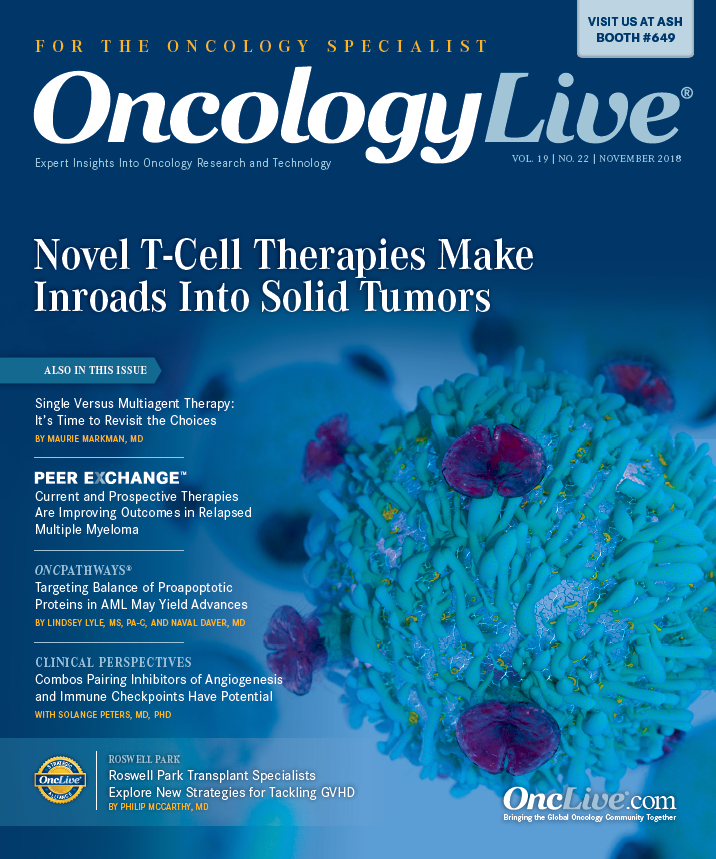Publication
Article
Oncology Live®
Evidence Grows for Tumor Mutational Burden as Predictor of Immunotherapy Success
Author(s):
Tumor mutational burden has been shown in studies to predict response to immunotherapies in certain types of cancer and is being validated in clinical trials as a biomarker of response.
Garrett Frampton, PhD

Garrett Frampton, PhD
An unmet need exists for biomarkers that can identify response to PD-1/PD-L1 blockade as well as other immunotherapies. Tumor mutational burden (TMB), a measure of the total number of somatic mutations per million bases of coding sequence in a tumor genome, has been shown in studies to predict response to immunotherapies in certain types of cancer and is being validated in clinical trials as a biomarker of response.
Results from studies have demonstrated that subsets of patients with high TMB exist across almost all cancer types and that assessing TMB through whole-exome sequencing or next-generation sequencing (NGS) can predict response to a range of different types of immunotherapy.
“[Results from] a recent phase III prospective study showed that high TMB was predictive of response to a frontline immunotherapy combination in patients with lung cancer,” said Garrett Frampton, PhD, senior director of cancer genomics research for Foundation Medicine in Cambridge, Massachusetts, which has developed solid and liquid tumor assays that test for TMB. “TMB is being studied in many other cancer types to better understand its predictive role. In the future, TMB has potential as a companion diagnostic for immunotherapy treatments,” Frampton told OncologyLive®.
In the study, investigators found that regardless of PD-L1 expression, in patients with non—small cell lung cancer (NSCLC) and high TMB, progression-free survival (PFS) was significantly longer with first-line nivolumab (Opdivo) plus ipilimumab (Yervoy) than with chemotherapy. The 1-year PFS among patients with high TMB was 42.6% with nivolumab plus ipilimumab versus 13.2% with chemotherapy. Median PFS was 7.2 months versus 5.5 months, respectively (HR, 0.58; 97.5% CI, 0.41-0.81; P <.001). The results were interpreted as a validation of the role of TMB as a biomarker for patent selection.1
TMB is being explored as a biomarker in NSCLC. The FDA currently is considering a supplemental biologics application for the combination of nivolumab (Opdivo) plus low-dose ipilimumab (Yervoy) for the frontline treatment of patients with advanced NSCLC with TMB ≥10 mutations per megabase.
Figure. bTMB in Independent of High PD-L1 Expression as Measured by IHC3
Blood-Based TMB Assay
Higher TMB levels are associated with higher levels of tumor neoantigens, which have the potential to enable the immune system to recognize and kill tumor cells. TMB can be measured through NGS. In a study to determine the value of TMB as a predictor of response to immunotherapy, investigators employed the FoundationOne CDx assay, which can evaluate base substitutions, chromosome insertions and deletions, whole gene copy number alterations, gene rearrangements, and microsatellite instability, as well as TMB. The study enrolled 151 patients across multiple tumor types, mainly NSCLC and melanoma. Results of the study showed that TMB, measured by NGS, could predict better outcomes from anti—PD-1/PD-L1 immunotherapy in multiple tumor types. Investigators found that the median TMB was 19 versus 5 mutations per megabase (mut/Mb) for responders versus nonresponders for all 151 patients (P = .0001).2Based on such studies, Frampton believes that tests for TMB have the potential to serve as companion diagnostics for immunotherapy treatments. Additionally, Frampton said, there is potential for a blood-based TMB test (bTMB) that could serve as an alternative to tissue biopsy. In fact, Foundation Medicine has received an FDA breakthrough designation for its FoundationACT assay for measuring bTMB. “A blood TMB test could provide a less invasive [way] to identify patients most likely to respond to immunotherapy,” Frampton said. However, bTMB evaluation depends on genomic profiling of tumor DNA that originates from the tumor and circulates in the bloodstream, where it is more difficult to detect.
Foundation Medicine’s investigational bTMB assay has been tested in lung cancer. Findings of the study, published in Nature Medicine, suggested that the assay could predict response to anti—PD-L1 immunotherapy atezolizumab (Tecentriq) in patients with previously treated NSCLC. The value of potential bTMB measurement in NSCLC is underscored by the fact that up to 30% of patients with NSCLC have inadequate tissue available at diagnosis for biomarker analysis.
The novel bTMB assay study was a retrospective analysis of more than 1000 tissue samples from patients with previously treated advanced NSCLC who participated in the POPLAR and OAK trials. Study authors wrote that overall, a positive correlation was observed between high tissue-based TMB (tTMB) and bTMB scores (Spearman rank correlation, 0.64; 95% CI, 0.56- 0.71),3 suggesting that relative to tTMB, bTMB can reliably identify patients who would derive clinically significant improvements in PFS from atezolizumab in second-line and higher advanced NSCLC.
Patients with bTMB ≥16 total mutations (14 mut/Mb) showed significantly improved PFS when treated with atezolizumab compared with those with bTMB ≥16 total mutations (14 mut/ Mb) treated with docetaxel chemotherapy (HR, 0.65; 95% CI, 0.47, 0.92; P = .013). “These are exciting times in lung cancer immunotherapy. Having a blood test that can identify those patients most likely to benefit would be a huge advantage for both physicians and patients,” said David R. Gandara, MD, lead author of the retrospective analysis, in a release.4
Frampton noted that 2 ongoing trials are evaluating Foundation Medicine’s bTMB assay: B-FAST (NCT03178552) and B-F1RST (NCT02848651).5,6 BFAST is a phase II/III screening and interventional umbrella trial for patients who are selected based on bTMB or somatic mutations. Eligible patients must have previously untreated advanced NSCLC. Two NGS circulating tumor DNA assays will be used. B-F1RST is a single-arm study evaluating atezolizumab and the association between bTMB and efficacy in nonbiomarker-selected patients with locally advanced or metastatic NSCLC.
Although PD-L1 expression can be a predictor of immunotherapy response, it is challenging to measure accurately, and some patients with high levels of PD-L1 do not have good outcomes with immunotherapy, while others with low PD-L1 expression do respond. TMB has potential to predict immunotherapy response in addition to and potentially independent of PD-L1 status, Frampton said (Figure).3 “TMB can be easier to measure accurately and has been shown to be more predictive than PD-L1 in studies,” he noted.
More Studies Neeeded
For patients with previously treated NSCLC and insufficient biopsy tissue who cannot use PD-L1 immunohistochemistry (IHC), the data published in Nature Medicine indicate that Foundation Medicine’s bTMB assay can help predict response to the anti—PD-L1 immunotherapy atezolizumab. The results also suggested that the bTMB assay may be an independent predictor of clinical benefit, regardless of PD-L1 biomarker expression as assessed by IHC for patients with NSCLC who had an available tissue biopsy.Additional data are necessary to further understand the role of TMB and other biomarkers. Frampton said that multiple biomarkers will likely be needed to accurately predict response to immunotherapy in a range of cancers. “Figuring out how to communicate this increasingly complex information to treatment teams will be a mounting challenge in the field,” he said. However, he expects genomic profiling in general to be much more widely implemented over the next 5 to 10 years for patients with life-threatening cancers. “TMB will likely be measured in all these patients.”
Before that can happen, there are several challenges that investigators must first overcome, such as developing diagnostic tests that are increasingly accurate and have a rapid turnaround time, finding ways to employ clinical trials and real-world data to identify the best treatment options, and effectively communicating new information to treatment teams so they can make the right decisions for their patients.
“The need for collaboration is critical for improving cancer care,” said Frampton, noting that Foundation Medicine is part of a consortium whose main goal is to standardize the definition, measurement standards, and analytic validation requirements for TMB to ensure consistency of TMB across platforms. “This sort of collaboration will be essential to accelerate additional research and potentially streamline regulatory and approval processes, with the aim of expanding availability of biomarker-driven treatments for patients,” he noted.
Foundation Medicine’s liquid assay received a breakthrough device designation from the FDA in April. The assay, an expansion of FoundationACT, tests more than 70 genes and biomarkers for microsatellite instability as well as bTMB. The promise of Foundation Medicine’s genomic tests contributed to a June 2018 decision by Roche to acquire all outstanding shares of Foundation Medicine that it does not already own. The deal was valued at $2.4 billion and left Foundation Medicine with a total valuation of $4.3 billion.
References
- Hellmann TE, Ciuleanu A, Pluzanski JS, et al. Nivolumab plus ipilimumab in lung cancer with a high tumor mutational burden. N Engl J Med. 2018;378(22):2093-104. doi: 10.1056/NEJMoa1801946.
- Goodman AM, Kato S, Bazhenova L, et al. Tumor mutational burden as an independent predictor of response to immunotherapy in diverse cancers. Mol Cancer Ther. 2017;16(11):2598-2608. doi: 10.1158/1535-7163.MCT-17-0386
- Gandara D, Paul S, Kowanetz M, et al. Blood-based tumor mutational burden as a predictor of clinical benefit in non-small-cell lung cancer patients treated with atezolizumab. Nat Med. 2018;24(9):1441-1448. doi: 10.1038_s4159- 018/018-0134-3.
- Foundation Medicine publishes new data in Nature Medicine supporting blood tumor mutational burden (bTMB) as a novel predictor of response to cancer immunotherapy [news release]. Cambridge, MA: Foundation Medicine. August 6, 2018. investors.foundationmedicine.com/news-releases/news-release- details/foundation-medicine-publishes-new-data-nature-medicine.
- A Study to Evaluate Efficacy and Safety of Multiple Targeted Therapies as Treatments for Participants With Non-Small Cell Lung Cancer (NSCLC) (B-FAST). clinicaltrials.gov/ct2/show/NCT03178552?cond=NCT03178552 &rank=1. Updated August 6, 2018. Accessed October 31, 2018.
- A Study of Atezolizumab as First-Line Monotherapy for Advanced or Metastatic Non-Small Cell Lung Cancer (B-F1RST). clinicaltrials.gov/ct2/show/ NCT02848651?cond=NCT02848651&rank=1. Updated September 5, 2018. Accessed October 31, 2018.





























%20(2)%201-Recovered-Recovered-Recovered-Recovered-Recovered-Recovered-Recovered-Recovered-Recovered-Recovered-Recovered-Recovered-Recovered-Recovered-Recovered-Recovered-Recovered.jpg?fit=crop&auto=format)
%20(2)%201-Recovered-Recovered-Recovered-Recovered-Recovered-Recovered-Recovered-Recovered-Recovered-Recovered-Recovered-Recovered-Recovered-Recovered-Recovered-Recovered-Recovered.jpg?fit=crop&auto=format)
